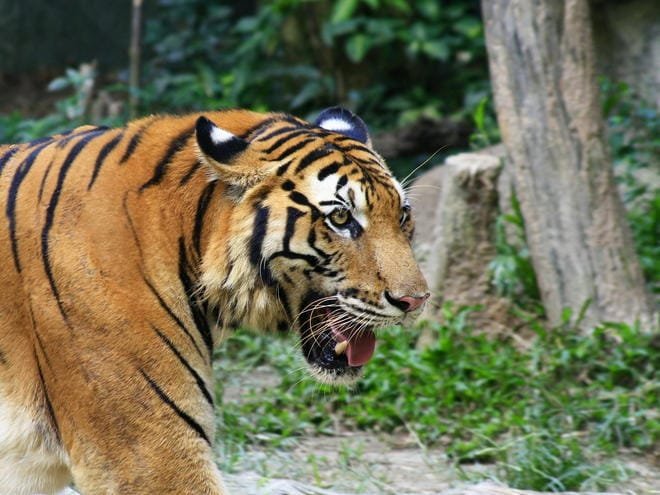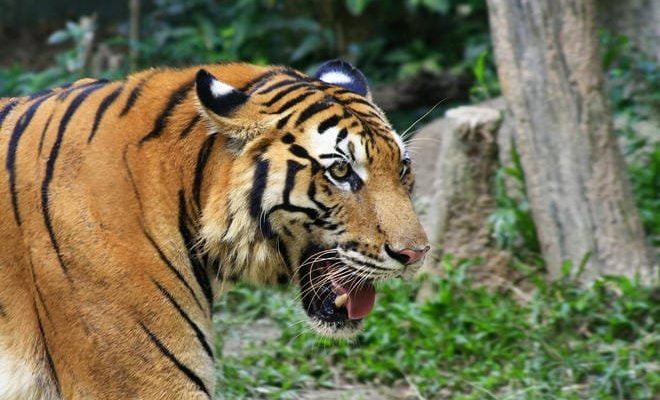
In this article, we’ll explore ten animals that resemble the South China tiger in various ways. Whether it’s their appearance, habitat, or behavior, each has something special that sets them apart. By the end, you’ll not only understand how to identify these animals but also appreciate the diversity within the wild. So, grab a cup of coffee, and let’s dive in!
1. Siberian Tiger
The Siberian tiger, or Amur tiger, is perhaps the closest relative to the South China tiger. Both belong to the Panthera tigris family, but the Siberian tiger is much larger. While the South China tiger is around 8 to 10 feet long, the Siberian tiger can reach lengths of 10 to 12 feet, making it the largest tiger subspecies.
How to tell them apart? Look at the fur! The Siberian tiger has a thicker coat, adapted to the colder climates of Russia. Its coloring is also slightly paler with fewer stripes, which helps it blend into the snowy environment. So next time you spot a tiger, check the fur texture and color to decipher if you’re looking at a Siberian or its southern cousin.
2. Bengal Tiger
The Bengal tiger is another big player in the tiger family. Known for its robust build, it’s found mainly in India and Bangladesh. Like the South China tiger, it features a vivid orange coat with distinct black stripes.
What sets them apart is their size and pattern. Bengal tigers tend to be larger and have a more pronounced black stripe pattern compared to the South China tiger. You might notice that the stripes on the Bengal tiger are thicker and more irregular, giving them a unique signature. Additionally, Bengal tigers have a more muscular build, making them even more formidable hunters.
3. Clouded Leopard
The clouded leopard is a smaller feline that might catch your eye for its beautiful coat. With large, cloud-like patches and longer limbs, this cat is often confused with smaller tigers—a common mix-up! They share the same habitats in Southeast Asia, making them neighbors in the wild.
To tell them apart, focus on their size and patterns. Clouded leopards are much smaller, weighing around 30 to 50 pounds, while the South China tiger can be over 400 pounds. The clouded leopard’s spots, often shaped like rain clouds, differ significantly from the tiger’s stripes, giving them a distinct look.
4. Jaguar
Next on our list is the jaguar, a magnificent big cat native to the Americas. Jaguars possess a stocky body and stunning rosette patterns on their fur. Though they’re not related to tigers, their similarities in build and pattern are undeniable.
What’s the difference? Jaguars have larger rosettes that often contain smaller dots inside them, unlike the more linear stripes of the South China tiger. Additionally, jaguars excel at swimming, a trait that differentiates them from their more land-based tiger cousins.
5. Leopard
Leopards are another feline that can resemble the South China tiger, especially from a distance. They share similar habitats across Africa and parts of Asia, making it easy to see why one might confuse them.
To identify a leopard, pay attention to their spots. Unlike tigers, leopards have tight rosettes—clusters of spots that make them look almost like they’re wearing a spotted coat. They’re also smaller and more agile than tigers, making them excellent climbers. If you ever find yourself wondering whether it’s a leopard or a tiger, remember: it’s all about those spots versus stripes!
6. Puma (Cougar)
The puma, or cougar, is often mistaken for a small leopard or even a small tiger due to its tawny coat. They’re incredibly adaptable and can thrive in various environments across the Americas, from deserts to forests.
To differentiate a puma from the South China tiger, consider their size and shape. Pumas are smaller, weighing around 100 to 220 pounds. They lack the distinct stripes of a tiger and instead have a solid color with a faint patch on their face. So, if you see a big cat lounging on a rock, check its size and coat—this can help clarify which feline you’re observing.
7. African Wildcat
The African wildcat is a distant relative of domestic cats and has a more uniform, sandy-brown coat. While they might not seem similar at first glance, they share a common ancestry with felines like the South China tiger.
To tell them apart, look at their size and behavior. African wildcats are much smaller, averaging around 20 pounds. They have a more slender and agile build, often stalking through the grasslands rather than prowling like a tiger. If you spot a small cat lurking in the bushes, chances are it’s not a tiger!
8. Asiatic Lion
While not a feline, the Asiatic lion is a big cat that holds a special place in the animal kingdom. Found primarily in India’s Gir Forest, their majestic appearance conjures images of the tiger’s regal stance.
What sets them apart? The Asiatic lion has a smaller mane than its African counterpart, and while they share habitats, they have unique behaviors. Lions are more social than tigers and live in prides. If you catch a glimpse of a pride lounging around, you can easily tell it’s not a solitary tiger!
9. Snow Leopard
The snow leopard is another captivating big cat known for its stunning beauty. These felines are found in the mountainous regions of Central and South Asia, where their thick fur helps them survive harsh conditions.
Here’s the thing—while they might have the feline family resemblance, their markings and size are quite different. Snow leopards are medium-sized, typically weighing between 60 to 120 pounds, and they have long tails and smoky grey fur with black rosettes. Compared to the South China tiger’s vibrant orange coat, the snow leopard’s coloration helps it blend into rocky terrains seamlessly.
10. Cheetah
Last but not least, the cheetah is perhaps the fastest land animal in the world. While they may look similar due to their sleek body and spots, they are a different breed altogether with unique characteristics.
Cheetahs are lighter and more slender than tigers, weighing around 77 to 143 pounds. Their coats feature black spots on a golden background, quite distinct from a tiger’s stripes. Plus, cheetahs are known for their sprinting abilities, making them the true speedsters of the animal kingdom.
In conclusion, the world of wildlife is rich with fascinating creatures, each with unique traits and stories to tell. Understanding the differences among these animals similar to the South China tiger helps deepen our appreciation for biodiversity. Whether you’re out exploring nature or enjoying a documentary at home, you now have the tools to identify and respect these extraordinary beings. So next time you encounter one of these majestic animals, remember their unique traits and characteristics—after all, every creature in the wild has its own tale to share!

